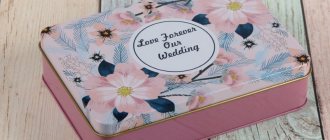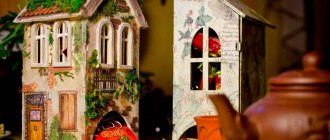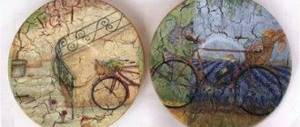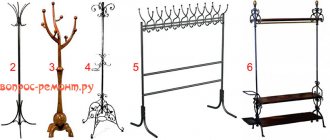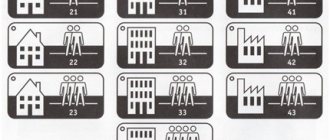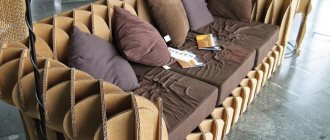Help the site, share with friends:
For Europeans, decorating a kitchen in African style is a very bold decision. Ignorance of the nuances of style and traditions of a foreign country makes exotic a rare design.
But it’s so interesting to create something unique and original.
Characteristics of Africa
To transform a kitchen in the spirit of the African savannas, you will need bright colors that betray eternal summer, the illusion of natural “wildness”.
Natural materials and warmth with comfort, unbridled passions will create an unusual interior.
Even in the cold of winter, warmth, freedom and originality will always reign in an African-style kitchen. Exotic motives quickly distract from everyday problems, quarrels and troubles.
What reminds you of Africa? These are animal motifs, plant designs, ethnic elements and souvenirs, warm colors and contrasts. An excellent advantage of the style is the ability to apply it to any layout, regardless of size.
Conceptual features of African style
When choosing materials, furniture and accessories to decorate the interior of your home, you should pay attention to the fact that the laconicism of visual traditions and rough primitivism are completely different things. For example, African sculpture has always used three-dimensional images, while European sculpture has used two-dimensional images. Plasticity is present in almost all details of the African style, even if they are created in an angular manner. In addition, you should take into account such nuances as the use of natural materials and a large number of textiles, the choice of an appropriate palette of colors and furniture.
Maximum proximity to nature
The naturalness of contours, materials, furnishings and accessories is the most important feature of African interior style. This does not mean that owners who have chosen this style to decorate their apartment or house will have to be prepared to spend a lot of money. Some parts can simply be replaced with an imitation “like natural material”. Thus, even wealthy families do not always have the opportunity to purchase ebony furniture, and suitable ivory products are generally very difficult to find in our latitudes. But in everything that is available, natural materials should be used as widely as possible.
To achieve the desired effect, you can use not only expensive types of wood or various curiosities. Here we should pay attention to all the materials that nature has given us in abundance. Good decor would be: - ceramic products; - rough clay sculptures or decorative dishes; - tree bark (ideal as a base for wall hangings).
African colors
The main color of Africa is brown of all shades; it can be used as the main background or only in details. There are no color restrictions for African-style kitchen design; all colors of the rainbow are suitable.
The advantage would be the use of terracotta, bright green, orange African sunset colors. This will resemble the uniqueness of African landscapes. Black and brown splashes in the decor will perfectly dilute the bright, life-affirming colors of the African continent.
Those who don’t like rich bright colors can take calmer white-black or sand-coffee shades with ethnic souvenirs or imitation of African motifs.
We decorate the interior in African style
Before you start working on styling the room, you should decide: Will the future interior fully correspond to the chosen direction, or is it planned to be enriched only with some elements that bring the flavor of Africa? What does the owner want to see when the room design is ready: high cost, simplicity, brightness, a feeling of warmth...? Do home owners have enough time to take care of the many natural details that are required by a real African style, or do they want to get an easy-to-maintain “practical fake”? And, of course, you should take into account the dimensions of the premises, their purpose, the presence of children and pets, as well as other factors. Below are a number of secrets that will help you “transfer” the African interior into your home, taking into account your possible wishes.
Floor
A stone floor is not just a tribute to style, but a decision dictated by necessity. In the African climate, the installation of such a cold floor is designed to make staying in a hot and stuffy room more comfortable. But the use of stone floors in the interior can make the home uncomfortable and cold. Therefore, it is necessary to install a heated floor system under the stone covering. This option is more suitable for living rooms, corridors and kitchens, and for flooring in bedrooms it is better to prefer a solution that will be “warmer” and without the mentioned system - this is a parquet floor or bamboo flooring, sold in the form of large slabs.
Ceiling
To create the illusion of being in a real African hut, you should use special bamboo ceiling tiles. They are either attached to the suspended ceiling sheathing or glued. Fans of original options can be advised to fix several dark wood beams in the ceiling area at a distance of 50-70 cm from each other and at a small distance from the ceiling itself. Long stalks of reed or bamboo are laid on them. You can “strengthen” the African style by attaching draperies to the ceiling. Both options have high heat and sound insulation characteristics, but the second is more expensive and more difficult to maintain. And it is also permissible to apply water-based paint to the ceiling or paste it with plain wallpaper.
Walls
The simplest option, both in creation and in visual perception of the result, is the usual wallpapering of walls. Their design, as mentioned above, should imitate the pattern of the fur of African animals or the skin of amphibians. A combination of plain wallpaper with colored ones will look great. For those who strive for the most calm design, you can simply paint the walls in a light warm shade or white.
Lovers of rich colors should consider options such as painting a bright border or decorating corners and edges with ornaments. The feeling of the presence of Africa can be enhanced by covering the walls with a pattern that imitates cracks in dry earth or by drawing the outlines of animals. But you can also “age the earth” with the help of special decorative plaster, which will look even more impressive. A fragment of the wall can be decorated using photo wallpaper with a corresponding thematic pattern or fabric with a printed pattern.
It is best to cover the walls of rooms with high humidity (kitchens and bathrooms) with mosaics or tiles that imitate reptile skin.
Color spectrum
African style in the interior is characterized by a special palette of shades. To decorate the premises, exclusively warm natural tones are used. Despite the fact that the weather is almost always hot outside, Africans do not strive to create a “cold effect” using appropriate shades. They, on the contrary, always decorated their huts and houses using rich, warm and “delicious” tones: red, orange, yellow, ocher-terracotta and chocolate. Clarity of detail was ensured by the use of a rich azure hue, and jet black was added to achieve contrast. You can’t do without black even when calm sandy and creamy shades are chosen to create the interior.
Textile design
Interior design in African style implies the presence of a large number of textiles. These are colorful carpets with unusual patterns, drapes, as well as fabrics with patterns of animal fur and amphibian skin. Very practical and aesthetic decorative elements will be the skins of African animals or their artificial copies. They can be used to cover floors, decorate walls, and be used as bedspreads and capes.
You can curtain the windows using linen roller blinds or bamboo blinds, which fit perfectly into the typically African decor of the room. Mats woven from coconut or palm fiber can be a good option for floor decoration. They are best placed on the veranda, terrace or at the foot of the chairs in the living room.
Furniture
African style involves the use of furniture made of natural dark wood or wickerwork (chairs, chests, tables, etc.). A rattan set consisting of a small number of items is an ideal option for furnishing a room. The fact is that an ethnic interior should contain a minimum of furniture, that is, only the essentials.
Decor elements
Interior design in African style involves the use of various objects of applied art. The aesthetics of the hottest continent can be emphasized with the help of figurines of people and animals, ritual masks and wooden utensils. When decorating a spacious room, it would be appropriate to use large floor-standing jugs and vases with African motifs in their designs. And you should forget about stuffed animals, which were very popular several decades ago (now their use is considered bad manners). In this case, the only exception can be the hunter’s house.
The above ideas and secrets should not be treated as rules that require strict adherence. They should be used based on the characteristics of your home, as well as personal circumstances and preferences. When decorating a house or apartment in African style, you should remember that it is one of the most dynamic trends in design. There is no doubt that its popularity will only grow, and the style itself will be constantly enriched with new fashion trends.
Furniture with an African twist
To convey untouched nature, only natural materials are needed. The color of the furniture can be white, black, brown, sand, reddish, even green - everything that is found in nature.
The shapes are simple, even rough, so it is better to order or buy from original craftsmen. Ideal styles: minimalism, ethno and eclecticism.
The ideal materials are: natural stones (imitation stone), dark wood or wenge, bamboo, and reed.
Awesome floor vase with African motifs! Master class from SIBIRIAN
Awesome floor vase with African motifs! Master class from SIBIRIAN You can go crazy from this beauty! Just look what you can make from a linoleum reel! Bravo to the author SIBERIAN! Thank you very much for the master class! The African vase is made from a paper reel, wrapped in hemp strands and... Anyway, see for yourself) Tomorrow I’ll go to hardware stores...
https://www.liveinternet.ru/users/4722581/post241614582/ NEXT TEXT OF AVORA: To begin with, I went to a construction store, got hold of a rather long bobbin from linoleum, my husband sawed off a 70 cm piece and the bottom was made of oval-shaped hardboard, arbitrary size. And I started. I impregnated the tube with wood impregnation in several layers, outside and inside.
Using this glue, I glued the bottom-base. I shifted it a little, that’s what I intended. I let it dry for a day until a strong bond formed, as hard as plastic.
Then I added a little gypsum to the dry non-shrink putty, mixed the solution with water, and added a little PVA glue. I did everything arbitrarily. The solution should turn out quite thick. She roughly applied it to the tube with her hands, as if wrapping it around it. The solution does not flow and dries for quite a long time. I wiped off the excess with a wet cloth.
Then I began to form ropes without waiting for complete drying. I did this using a palette knife and a small kitchen knife. There was no dust, but there was a lot of debris.
I scraped out the shape of the twisted ropes. Considering that this was my first time doing this, I was pleased with the result. I didn’t plan to make the ropes rough. Now I’m already thinking differently. Yes, and there is an idea how to do it. This is what the edge of the tube looked like from the outside.
So from the inside. I dried it for a long time, for a week. Then I cut out motifs from a napkin and tried on how I would arrange them. I separated the third layer from the motifs and pasted them on the places I needed.
Then I applied the same mixture to the places I needed. And I pasted the second layer of tissue paper on top. I didn't achieve smoothness.
I added another one to the strands, as if wrapping it around the entire bundle. I covered it with white layers of napkins for strength; I didn’t remove folds and wrinkles, I wanted to preserve some roughness. As a result, everything was hidden under paint and varnish. Based on the motifs of the figures, the volume was created using “Moment” glue for polystyrene. it is more plastic compared to putty. I primed only for the motifs. Then, I decoupaged the spaces between the motifs with leopard print napkins. I dimmed the brightness with acrylic paints and painted over the ropes. I left only the vine and secured it with varnish. I applied craquelure on PVA under the female figures. It looks like earth bursting from the heat. Then in between I applied a pair of craquelure 753-754. There were small cracks. Rubbed it with gold pigment. Varnish. Then another couple of 739-740 for large cracks. I got the depth effect I liked
This is cold porcelain, tinted green.
And these are stencils for vine leaves. I made them in different sizes. Since I don’t have molds, I used these.
This is how I made the leaves, using a pin I traced the stencil.
I painted the trunk of the vine in the desired color, glued on the leaves without waiting for the porcelain to dry, starting from the bottom with the largest ones. Adding flagella and petioles to the leaves. I painted and tinted the leaves that were already glued on.
That's how it happened.
In this photo you can see the craquelure.
Somehow like this. Many processes are skipped, there are no photos. After all, during work, you can’t always remember in time. A few contours didn’t hurt, the figures became brighter.
Inside, as far as the hand can reach, it is ennobled. Varnished to the bottom, using a stick with foam rubber.
Source stranamasterov.ru/blog/75165
African details
For an ethnic interior, thematic accessories are required:
- The kitchen should not be overloaded with bright details, only 2-3 items.
- Pottery will emphasize originality, even in decor.
- Geometric shapes are only simple; complexity contradicts the style.
- An original African accent will be a “leopard” tablecloth or upholstery of chairs and sofas.
- You can choose photo wallpaper on your kitchen apron with a panorama of African savannahs, red sunsets, wild animals, etc.
- Homemade items that highlight style are welcome.
- Nowadays there are a lot of African-themed textiles, figurines and masks on sale.
Paint your kitchen with exotic colors!
“ Adding stylized prints that are associated with African style will add expressiveness”
The freest style, which knows no boundaries and restrictions in the choice of shades, is “African”. Of course, one should not confuse such concepts as tasteless tackiness and harmony of bright colors.
African-style kitchen cabinet furniture should be rough and uncouth
To avoid mistakes in interior design, you need to determine what exactly you want to see in your kitchen and base your choice of colors on the desired theme:
- the freshness of the tropical jungle - bright green, olive, orange, light green yellow, sky blue, turquoise;
- sweltering desert - red, sand, light yellow, white, beige, reddish-orange, brown;
- endless savanna: black, dark brown, terracotta, bright yellow, light green, all shades of blue.
an accent wall with African motifs and a rug with animal prints fit perfectly into the African style of the kitchen interior
Adding stylized prints that are associated with African style to the selected kitchen color scheme will add expressiveness. Prints that imitate:
- stylized rock paintings;
- tiger stripes;
- large giraffe spots;
- black and white zebra stripes;
- crocodile skin;
- snake motifs;
- leopard skin;
- open palm leaves;
- bamboo stems.
masks in the interior of an African-style kitchen
Decorating the walls, floor and ceiling of the kitchen in African style
Only by using natural materials or their high-quality imitation, you can achieve a beautiful and harmonious kitchen interior in African style .
A huge range of finishing materials gives you the opportunity to choose crocodile or leopard skin tiles. In addition, it will not be difficult to find wallpaper that imitates bamboo stems or has “rock paintings.” The best option for the floor is porcelain stoneware, replacing natural stone. A wooden floor will also fit organically into the space if it is made of large floorboards with a pronounced relief. Sisal, bamboo, reed, bronze and leather elements, natural fabrics will emphasize African motifs and add atmosphere.
a wide arched opening and a beamed ceiling are an important touch in the African style of kitchen interior
An African-style kitchen can have:
- beam ceiling;
- walls finished with coarse plaster;
- sofas or armchairs, the upholstery of which imitates animal skin;
- “plank floor” in the eating area;
- stone-like floor in the cooking area;
- furniture made from wicker or natural wood.
As for wallpaper, you can choose models made from natural materials or their imitation, as well as models that already have a stylistic focus - with images of African women, animals, and household items.
African style kitchen accessories
It is advisable to have heated floors for an African-style kitchen. This addition of modern technology brings some comfort to the “primitive” African interior.
The windows in such a kitchen do not have the right to be white and, in addition, are practically devoid of decor. The maximum you can afford is a fabric that imitates mesh or light organza.
African cuisine decor
To decorate the kitchen interior we will use natural textiles with large geometric patterns. We will cover the doorway with straight heavy drapery, and the window with a thin veil, which will imitate a mosquito net.
African style in the interior is distinguished by an abundance of specific accessories:
- clay and wooden kitchen utensils;
- vessels made of coconut and dried pumpkin;
- climbing exotic plants;
- replicas of tropical fruits;
- bamboo coasters for dishes;
- tapestries with images of animals;
- compositions from bird feathers.
Hunting trophies fit most organically into the style of African interiors: stuffed animals, skins on the floor, wall medallions with antlers. But it’s better to leave the animals to graze in the wild, and instead of natural attributes, we will acquire artificial ones. If your everyday life is devoid of exoticism, and home dinners have begun to seem bland, African style in the interior will add new colors to your time in the kitchen. The hot sun of Africa, magically reflected in the original design, will not only warm you up on a frosty day, but will also enrich your family relationships with warmth.
